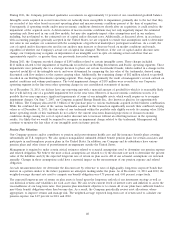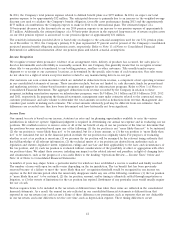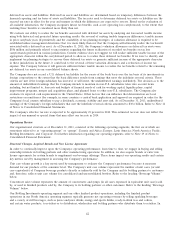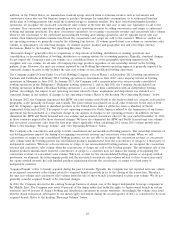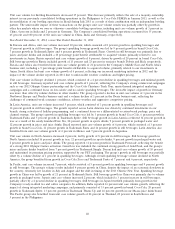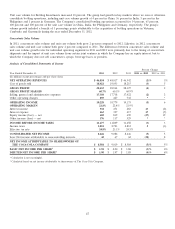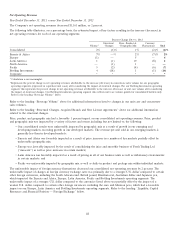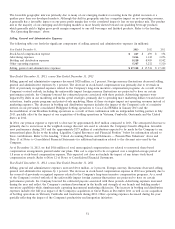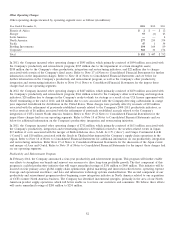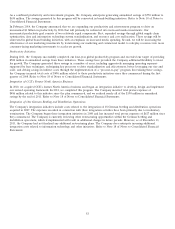Coca Cola 2013 Annual Report Download - page 45
Download and view the complete annual report
Please find page 45 of the 2013 Coca Cola annual report below. You can navigate through the pages in the report by either clicking on the pages listed below, or by using the keyword search tool below to find specific information within the annual report.addition, in the United States, we manufacture fountain syrups and sell them to fountain retailers such as restaurants and
convenience stores who use the fountain syrups to produce beverages for immediate consumption, or to authorized fountain
wholesalers or bottling partners who resell the fountain syrups to fountain retailers. For these consolidated finished product
operations, we recognize the associated concentrate sales volume at the time the unit case or unit case equivalent is sold to the
customer. Our concentrate operations typically generate net operating revenues by selling concentrates and syrups to authorized
bottling and canning operations. For these concentrate operations, we recognize concentrate revenue and concentrate sales volume
when we sell concentrate to the authorized unconsolidated bottling and canning operations, and we typically report unit case
volume when finished products manufactured from the concentrates and syrups are sold to the customer. When we analyze our
net operating revenues we generally consider the following four factors: (1) volume growth (unit case volume or concentrate sales
volume, as appropriate), (2) structural changes, (3) changes in price, product and geographic mix and (4) foreign currency
fluctuations. Refer to the heading ‘‘Net Operating Revenues’’ below.
‘‘Structural changes’’ generally refers to acquisitions or dispositions of bottling, distribution or canning operations and
consolidation or deconsolidation of bottling, distribution or canning entities for accounting purposes. Typically, structural changes
do not impact the Company’s unit case volume on a consolidated basis or at the geographic operating segment level. We
recognize unit case volume for all sales of Company beverage products regardless of our ownership interest in the bottling
partner, if any. However, the unit case volume reported by our Bottling Investments operating segment is generally impacted by
structural changes because it only includes the unit case volume of our consolidated bottling operations.
The Company acquired Great Plains Coca-Cola Bottling Company (‘‘Great Plains’’) in December 2011, bottling operations in
Vietnam and Cambodia in February 2012, bottling operations in Guatemala in June 2012, and a majority interest in bottling
operations in Myanmar in June 2013. In January 2013, the Company sold a majority interest in our previously consolidated
bottling operations in the Philippines (‘‘Philippine bottling operations’’), and in July 2013 the Company deconsolidated our
bottling operations in Brazil (‘‘Brazilian bottling operations’’) as a result of their combination with an independent bottling
partner. Accordingly, the impact to net operating revenues related to these acquisitions and dispositions was included as a
structural change in our analysis of changes to net operating revenues. Refer to the heading ‘‘Net Operating Revenues’’ below.
In January 2012, the Company announced that BPW, our joint venture with Nestl´
e in the ready-to-drink tea category, refocused its
geographic scope primarily on Europe and Canada. The joint venture was phased out in all other territories by the end of 2012,
and the Company’s agreement to distribute products in the United States under a sublicense from a subsidiary of Nestl´
e
terminated at the end of 2012. The impact to net operating revenues for North America related to the termination of our license
agreement has been included as a structural change in our analysis of changes to net operating revenues. In addition, we have
eliminated the BPW and Nestl´
e licensed unit case volume and associated concentrate sales for the year ended December 31, 2012,
in those countries impacted by these structural changes. We have also eliminated the BPW and Nestl´
e licensed unit case volume
and associated concentrate sales from the base year, where applicable, when calculating 2012 versus 2011 volume growth rates.
Refer to the headings ‘‘Beverage Volume’’ and ‘‘Net Operating Revenues’’ below.
The Company sells concentrates and syrups to both consolidated and unconsolidated bottling partners. The ownership structure of
our bottling partners impacts the timing of recognizing concentrate revenue and concentrate sales volume. When we sell
concentrates or syrups to our consolidated bottling partners, we are not able to recognize the concentrate revenue or concentrate
sales volume until the bottling partner has sold finished products manufactured from the concentrates or syrups to a third party or
independent customer. When we sell concentrates or syrups to our unconsolidated bottling partners, we recognize the concentrate
revenue and concentrate sales volume when the concentrates or syrups are sold to the bottling partner. The subsequent sale of the
finished products manufactured from the concentrates or syrups to a customer does not impact the timing of recognizing the
concentrate revenue or concentrate sales volume. When we account for the unconsolidated bottling partner as an equity method
investment, we eliminate the intercompany profit and the associated concentrate sales volume related to these transactions until
the equity method investee has sold finished products manufactured from the concentrates or syrups to a third party or
independent customer.
‘‘Acquired brands’’ refers to brands acquired during the past 12 months. Typically, the Company has not reported unit case volume
or recognized concentrate sales volume related to acquired brands in periods prior to the closing of the transaction. Therefore,
the unit case volume and concentrate sales volume from the sale of these brands is incremental to prior year volume. We do not
generally consider acquired brands to be structural changes.
In 2012, the Company invested in the existing beverage business of Aujan, one of the largest independent beverage companies in
the Middle East. The Company now owns 50 percent of the Aujan entity that holds the rights to Aujan-owned brands in certain
territories and 49 percent of Aujan’s bottling and distribution operations in certain territories. Accordingly, the volume associated
with the Aujan transaction, subsequent to our initial equity investment during the second quarter of 2012, is considered to be from
acquired brands. Refer to the heading ‘‘Beverage Volume’’ below.
43









